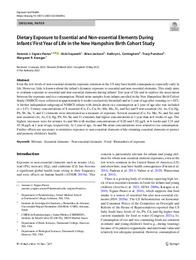Resumen :
Even the low levels of non-essential elements exposure common in the US may have health consequences especially early in life. However, little is known about the infant’s dynamic exposure to essential and non-essential elements. This study aims to evaluate exposure to essential and non-essential elements during infants’ first year of life and to explore the association between the exposure and rice consumption. Paired urine samples from infants enrolled in the New Hampshire Birth Cohort Study (NHBCS) were collected at approximately 6 weeks (exclusively breastfed) and at 1 year of age after weaning (n = 187). A further independent subgroup of NHBCS infants with details about rice consumption at 1 year of age also was included (n = 147). Urinary concentrations of 8 essential (Co, Cr, Cu, Fe, Mn, Mo, Ni, and Se) and 9 non-essential (Al, As, Cd, Hg,
Pb, Sb, Sn, V, and U) elements were determined as a measure of exposure. Several essential (Co, Fe, Mo, Ni, and Se) and non-essential (Al, As, Cd, Hg, Pb, Sb, Sn, and V) elements had higher concentrations at 1 year than at 6 weeks of age. The
highest increases were for urinary As and Mo with median concentrations of 0.20 and 1.02 μg/L at 6 weeks and 2.31 and 45.36 μg/L at 1 year of age, respectively. At 1 year of age, As and Mo urine concentrations were related to rice consumption.
Further efforts are necessary to minimize exposure to non-essential elements while retaining essential elements to protect and promote children’s health.
|

 La licencia se describe como: Atribución-NonComercial-NoDerivada 4.0 Internacional.
La licencia se describe como: Atribución-NonComercial-NoDerivada 4.0 Internacional.
.png)